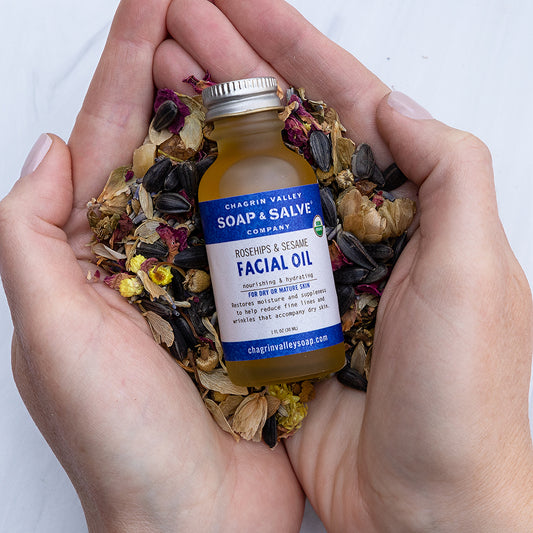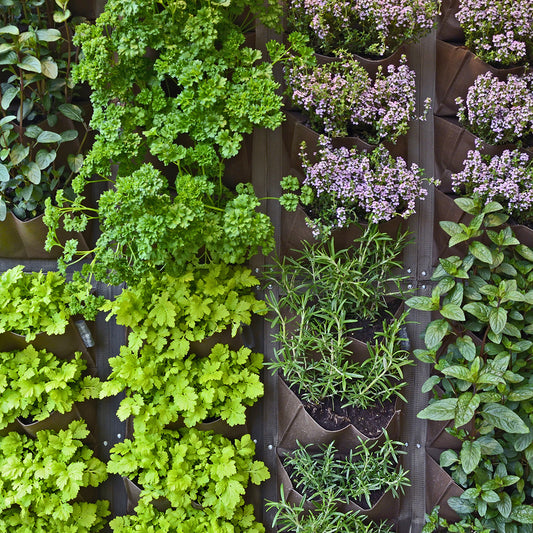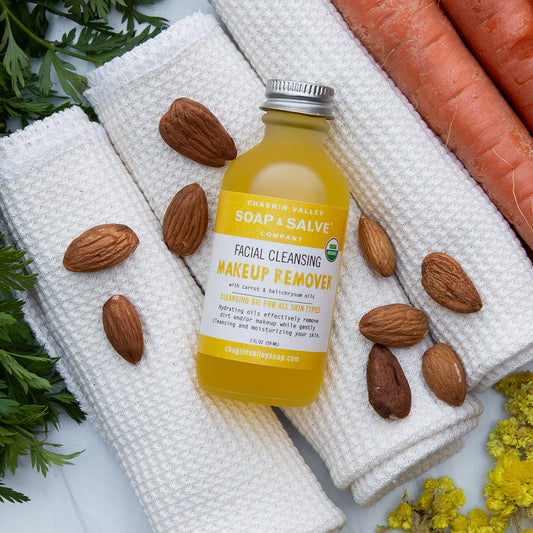What Is A Hydrosol?
 We have received numerous questions from customers asking "What is a Hydrosol." As interest in plant and nature-based personal care steadily increases, hydrosols have been gaining popularity.
We have received numerous questions from customers asking "What is a Hydrosol." As interest in plant and nature-based personal care steadily increases, hydrosols have been gaining popularity.
Hydrosols are often discussed along with essential oils which makes sense since essential oils cannot be made without also producing a hydrosol.
The word HYDROSOL is formed from the combination of two words "hydro" meaning water and "sol" meaning solution.
That sounds simple enough. However, if you want to purchase a true hydrosol it can become very confusing because of the ways in which similar products are named.
Hydrosols may also be called hydrolats, hydrolates, distillates, flower waters, and most commonly floral waters. However, it is not accurate to call all hydrosols "floral" water since hydrosols can also be distilled from the leaves, bark, stems, roots, and other parts of the plant.
To cause further confusion, there are other products with names like distilled waters, botanical waters, floral spritzers, plant waters, aromatic waters, and others.
In the "natural" products market, many of these terms get used interchangeably with the word "hydrosol." Although some of these products may be true hydrosols, others may be completely different products and some may even be synthetic.
What Are True Hydrosols?
Hydrosols are the pure and natural waters that are produced during the steam distillation of plant materials such as leaves, flowers, peels, berries, wood, stems, and roots. They are produced during the same distillation process that also extracts the essential oils.
The fresh-cut plant material is placed into a distillation tank or still (see drawing below).
As the water in the tank boils, the steam rises up through the plant and softens specialized scent glands that secrete essential oils.
These glands, called glandular trichomes, are tiny, specialized hair-like growths found in various parts of almost all plants.
 The rising steam causes the trichomes to burst, allowing the essential oil that is contained within them to be released as a vapor.
The rising steam causes the trichomes to burst, allowing the essential oil that is contained within them to be released as a vapor.
This essential oil vapor mixes with the steam and rises into the coils of the condensing chamber, which are surrounded by cold water. The condensing tank cools the steam and vapor, which then pours into the separator tank as a mixture of water and essential oil.
Due to the difference in specific gravity between the essential oil and water, most of the essential oil separates out and floats to the surface where it is removed.
The water that is left behind in the bottom of the separator is the hydrosol which contains minute amounts, about 0.2%, of essential oils which give hydrosols their fragrant scent.
The distillation process transforms fresh natural nutrient-rich plant material into a "tonic" water that contains the water-soluble therapeutic properties of the plant that are not present in the essential oil.
Just like essential oils, there are many factors that can affect the quality of a hydrosol. These factors include: when the plant is harvested, the yearly changes in weather, how much plant material vs water goes into the still, which parts of the plant are used, the heat of the distillation, the length of the distillation process, the type of still use, and so on.
Again, although an essential oil and a hydrosol are both products of plant distillation, the essential oil is the very concentrated oil from distillation and the hydrosol is the water-based byproduct of the distillation process with very small amount of essential oil suspended within it.
While I guess it is accurate to call hydrosols a simple by-product of pure essential oil distillation, hydrosols are really much more.
Essential oils and hydrosols have been distilled for thousands of years. It is interesting to note that the primary focus of ancient distillers was hydrosols rather than essential oils. When essential oils gained popularity in the late 1700s hydrosols were discarded in the western world. They were seen as an unwanted byproduct, the simple leftovers, from the distillation of essential oils.
While many hydrosols sold today are still produced as a result of essential oil distillation, some companies that do not make essential oils distill plant material strictly to produce the hydrosols.
If you would like to attempt to make your own, there are numerous "how-to" articles and videos available. Since hydrosols are a product of distillation you will need some sort of still, either bought or handmade.
How To Use Hydrosols
Hydrosols are much gentler than their essential oil counterparts and unlike most essential oils that should be diluted before using them on your skin, hydrosols can be applied directly to the skin. They are generally safe for all ages, those with sensitive skin, and even pets.
Hydrosols may be less concentrated but they can offer subtle aromatherapy and their own therapeutic benefits.
 There are numerous articles on the internet that describe the many ways in which to use hydrosols, so I am not going to spend a lot of time on that subject in this blog.
There are numerous articles on the internet that describe the many ways in which to use hydrosols, so I am not going to spend a lot of time on that subject in this blog.
Each type of hydrosol brings its own unique benefits to the skin. They can be used as a mild facial toner or cleanser, a hair and scalp tonic, or an aromatic mist.
They can be added to baths or used to mix up your favorite clay masks. You can create your own special facial moisturizer by adding a spritz of hydrosol after applying facial oil.
Hydrosols can also be used for air freshening, linen sprays, garment freshening, and hair fragrance misters.
Their soft and subtle fragrance may also provide gentle aromatherapy.
Witch Hazel: A Familiar Hydrosol
One quite common hydrosol used as a natural remedy is Witch Hazel. This hydrosol is the result of the steam distillation of dried leaves, bark, and twigs of the Witch Hazel, Hamamelis virginiana, plant.
Witch Hazel contains tannins, natural compounds with astringent properties, which makes it a popular ingredient in facial toners. It has also been used for ages topically to soothe irritated skin and treat certain skin conditions.
 Like other true hydrosols, Witch Hazel should not contain any additives. Since pure Witch Hazel hydrosol is "water" it is difficult to find it without some sort of preservative.
Like other true hydrosols, Witch Hazel should not contain any additives. Since pure Witch Hazel hydrosol is "water" it is difficult to find it without some sort of preservative.
Therefore, not all bottles of Witch Hazel are TRUE hydrosols, so be careful and read the labels.
Some Witch Hazel is actually an extraction in alcohol and is usually sold as “Witch Hazel Extract.” Although it is not a true hydrosol, that does not mean that it is a bad product.
When buying witch hazel extract, be sure to look for a solvent-free extraction of certified organic material with low alcohol content. The better quality companies will often double distill their organic plant material. Look for extracts that contain less than 15% organic alcohol (Ethanol). Many commercial witch hazel extracts commonly found in grocery stores are very high in alcohol and low in witch hazel.
Some items sold as Witch Hazel may contain a chemical soup of added ingredients like isopropyl alcohol, polysorbate 20, sodium hydroxide, sodium citrate, alcohol, citric acid, menthol, benzophenone-4, disodium EDTA, fragrance, red 4, blue 1, ext.
In my opinion, any possible benefit you would receive from the Witch Hazel will be negated by the chemical soup of synthetic ingredients.
Botanical, Aromatic, or Floral Waters . . . Oh My!
As I mentioned at the beginning of this blog there are numerous products on the market with names like botanical waters, aromatic waters, floral waters, etc. While some may be true hydrosols, others may be completely different products. An essential oil mixed in plain water is NOT a hydrosol nor is a flower essence extract with artificial fragrance or preservative.
That's not to say that some of the natural floral misters, spritzers, waters, etc. have no use. I often make my own aromatic waters for cleaning, disinfecting, and room scenting by mixing a few drops of pure essential oils with water. However, these are NOT the true distilled hydrosols that contain the therapeutic benefits of the whole plant.
If you are looking for true hydrosols beware of imposters. Unfortunately, you may not be able to tell if the hydrosol is "fake" by simply looking or smelling. Names and even label ingredients may be deceiving.
As you shop ask lots of questions and read labels. Choose a reputable supplier that is willing to share basic information about their hydrosols.
These are a few of the products often passed off as true hydrosols.
Water Simply Blended with Essential Oils: Often called "flower waters," these products make nice body misters or room deodorizers.
Since they are NOT true hydrosols they will lack the therapeutic benefits obtained from a distillation of the whole plant.
These added therapeutic qualities result from the unique water-soluble plant chemicals found in the water portion of the distillate that are not present in the essential oil.
Water Blended with Essential Oils and a Solubilizer: Sometimes a solubilizer or an emulsifier is added to the "flower waters" to help the essential oil remain mixed in the water. While there are natural solubilizers, more often than not they are synthetic.
Here is a tip, shake the bottle--a real hydrosol will not get foamy when shaken.
Water Mixed with Synthetic Fragrance Oils: This is an easy and inexpensive way to make scented water. Many of these products include synthetic colors. Need I say anything more?
 Floral or Botanical Infusions: Also called "herbal teas" or "tisanes," these are simply a "tea" in which plant material is steeped in water.
Floral or Botanical Infusions: Also called "herbal teas" or "tisanes," these are simply a "tea" in which plant material is steeped in water.
Since they are not distilled they are not as "potent" or complex as a true hydrosol and should not be sold as a hydrosol.
However, botanical infusions often have properties that when used topically are beneficial for the skin.
Many topical botanical teas have antibacterial, anti-inflammatory, and/or antioxidant properties. They can be used as toners or gentle skin cleansers. They can also be added to facial clay masks or used as compresses for skin irritation.
Store-bought herbal water infusions will need preservatives so you are better off preparing them yourself.
We have some good information in two of our blogs "How To Use Organic Facial Herbs" and "How To Use Bathing Herbs" about how to use "teas" in a skincare regimen.
A Few More Things To Consider When Purchasing Hydrosols
As I stated above, if you are shopping for true hydrosols ask lots of questions and read the labels. Always choose a reputable supplier that is willing to share basic information about their hydrosols.
Some companies will try to cover up poor distillation techniques by enhancing their hydrosols with essential oils.
True Hydrosols are Perishable!
Since a true hydrosol is the water leftover from the steam distillation of plant material, hydrosols are very perishable. Unlike their essential oil counterparts, hydrosols are water-based and have a shorter shelf life.
Although the shelf life of hydrosols can be prolonged by refrigeration, changes in temperature and improper use can easily cause spoilage.
The shelf life of a hydrosol depends on the specific botanical used to make the product, its pH level, the method of distillation, the storage conditions of the hydrosol, and of course how it is handled and bottled.
Reputable manufacturers use proper distillation methods and sterile conditions throughout the entire process including bottling.
It is best to purchase hydrosols in clear glass bottles. Write the date that you received the hydrosol on the label and observe the color, clarity, and scent. A hydrosol should be clear. Contaminated or old hydrosols sometimes grow a bloom. Bloom is a cloudy substance that can settle towards the bottom and looks a bit like the "mother" you see in natural raw vinegar. If a bloom appears or the scent goes off and you suspect that your hydrosol has gone bad discard it immediately.
Beware of Preservatives
Pure hydrosols should not be preserved with any additives, including alcohol. However, companies mass-producing hydrosols for retail sale often add preservatives to give their products longer shelf life.
If the shelf-life of your hydrosol is not listed, you should ask! Under ideal storage conditions, hydrosols generally have a shelf life of about only 6-8 months and ideally, they should be stored in the refrigerator.
Do you use hydrosols?
If yes . . . how do you use them?
Any hints or advice for those new to hydrosols?


